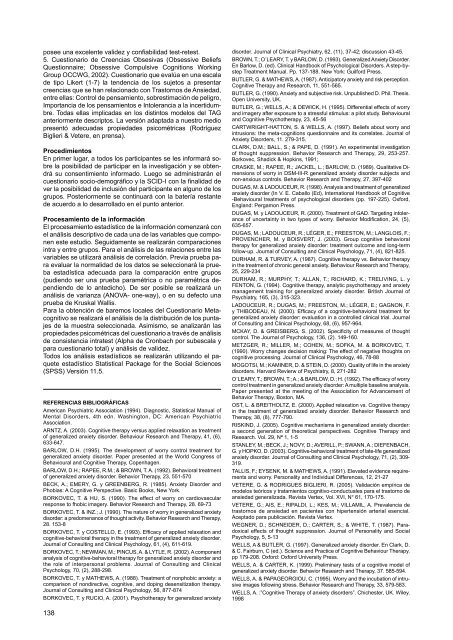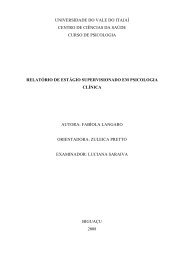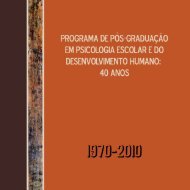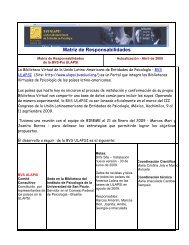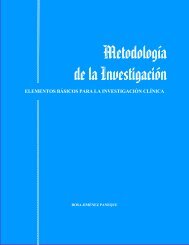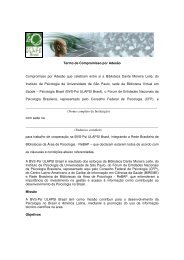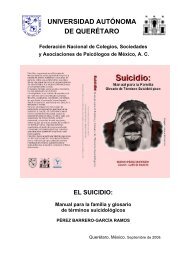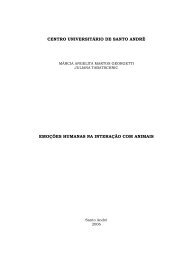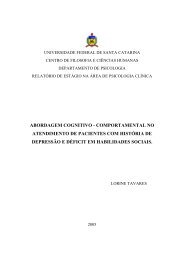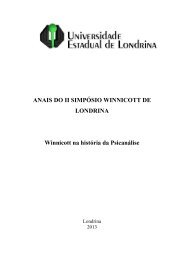Tomo I
Tomo I
Tomo I
You also want an ePaper? Increase the reach of your titles
YUMPU automatically turns print PDFs into web optimized ePapers that Google loves.
posee una excelente validez y confiabilidad test-retest.5. Cuestionario de Creencias Obsesivas (Obsessive BeliefsQuestionnaire; Obsessive Compulsive Cognitions WorkingGroup OCCWG, 2002). Cuestionario que evalúa en una escalade tipo Likert (1-7) la tendencia de los sujetos a presentarcreencias que se han relacionado con Trastornos de Ansiedad,entre ellas: Control de pensamiento, sobrestimación de peligro,Importancia de los pensamientos e Intolerancia a la incertidumbre.Todas ellas implicadas en los distintos modelos del TAGanteriormente descriptos. La versión adaptada a nuestro mediopresentó adecuadas propiedades psicométricas (RodríguezBiglieri & Vetere, en prensa).ProcedimientosEn primer lugar, a todos los participantes se les informará sobrela posibilidad de participar en la investigación y se obtendrásu consentimiento informado. Luego se administrarán elcuestionario socio-demográfico y la SCID-I con la finalidad dever la posibilidad de inclusión del participante en alguno de losgrupos. Posteriormente se continuará con la batería restantede acuerdo a lo desarrollado en el punto anterior.Procesamiento de la informaciónEl procesamiento estadístico de la información comenzará conel análisis descriptivo de cada una de las variables que componeneste estudio. Seguidamente se realizarán comparacionesintra y entre grupos. Para el análisis de las relaciones entre lasvariables se utilizará análisis de correlación. Previa prueba paraevaluar la normalidad de los datos se seleccionará la pruebaestadística adecuada para la comparación entre grupos(pudiendo ser una prueba paramétrica o no paramétrica dependiendode lo antedicho). De ser posible se realizará unanálisis de varianza (ANOVA- one-way), o en su defecto unaprueba de Kruskal Wallis.Para la obtención de baremos locales del Cuestionario Metacognitivose realizará el análisis de la distribución de los puntajesde la muestra seleccionada. Asimismo, se analizarán laspropiedades psicométricas del cuestionario a través de análisisde consistencia intratest (Alpha de Cronbach por subescala ypara cuestionario total) y análisis de validez.Todos los análisis estadísticos se realizarán utilizando el paqueteestadístico Statistical Package for the Social Sciences(SPSS) Versión 11.5.REFERENCIAS BIBLIOGRÁFICASAmerican Psychiatric Association (1994). Diagnostic, Statistical Manual ofMental Disorders, 4th edn. Washington, DC: American PsychiatricAssociation.ARNTZ, A. (2003). Cognitive therapy versus applied relaxation as treatmentof generalized anxiety disorder. Behaviour Research and Therapy, 41, (6),633-647.BARLOW, D.H. (1995). The development of worry control treatment forgeneralized anxiety disorder. Paper presented at the World Congress ofBehavioural and Cognitive Therapy, Copenhagen.BARLOW, D.H.; RAPEE, R.M.; & BROWN, T. A. (1992). Behavioral treatmentof generalized anxiety disorder. Behavior Therapy, 23, 551-570BECK, A.; EMERY, G. y GREENBERG, R. (1985). Anxiety Disorder andPhobias: A Cognitive Perspective. Basic Books, New York.BORKOVEC, T. & HU, S. (1990). The effect of worry on cardiovascularresponse to fhobic imagery. Behavior Research and Therapy, 28. 69-73BORKOVEC, T. & INZ.; J. (1990). The nature of worry in generalized anxietydisorder: a predomenance of thought activity. Behavior Research and Therapy,28. 153-8BORKOVEC, T. y COSTELLO, E. (1993). Efficacy of applied relaxation andcognitive-behavioral therapy in the treatment of generalized anxiety disorder.Journal of Consulting and Clinical Psychology, 61, (4), 611-619.BORKOVEC, T.; NEWMAN, M.; PINCUS, A. & LYTLE, R. (2002). A componentanalysis of cognitive-behavioral therapy for generalized anxiety disorder andthe role of interpersonal problems. Journal of Consulting and ClinicalPsychology, 70, (2), 288-298.BORKOVEC, T. y MATHEWS, A. (1988). Treatment of nonphobic anxiety: acomparison of nondirective, cognitive, and doping desensitization therapy.Journal of Consulting and Clinical Psychology, 56, 877-874BORKOVEC, T. y RUCIO, A. (2001). Psychotherapy for generalized anxietydisorder. Journal of Clinical Psychiatry, 62, (11), 37-42; discussion 43-45.BROWN, T.; O´LEARY, T. y BARLOW, D. (1993). Generalized Anxiety Disorder.En Barlow, D. (ed). Clinical Handbook of Psychological Disorders. A step-bystepTreatment Manual. Pp. 137-188. New York: Guilford Press.BUTLER, G. & MATHEWS, A. (1987). Anticipatory anxiety and risk perception.Cognitive Therapy and Research, 11, 551-565.BUTLER, G. (1990). Anxiety and subjective risk. Unpublished D. Phil. Thesis.Open University, UK.BUTLER, G.; WELLS, A.; & DEWICK, H. (1995). Differential effects of worryand imagery after exposure to a stressful stimulus: a pilot study. Behaviouraland Cognitive Psychotherapy, 23, 45-56CARTWRIGHT-HATTON, S. & WELLS, A. (1997). Beliefs about worry andintrusions: the meta-cognitions questionnaire and its correlates. Journal ofAnxiety Disorders, 11. 279-315.CLARK, D.M.; BALL, S.; & PAPE, D. (1991). An experimental investigationof thought suppression. Behavior Research and Therapy, 29, 253-257.Borkovec, Shadick & Hopkins, 1991;CRASKE, M.; RAPEE, R.; JACKEL, L.; BARLOW, D. (1989). Qualitative Dimensionsof worry in DSM-III-R generalized anxiety disorder subjects andnon-anxious controls. Behavior Research and Therapy, 27, 397-402DUGAS, M. & LADOUCEUR, R. (1998). Analysis and treatment of generalizedanxiety disorder (In V. E. Caballo (Ed), International Handbook of Cognitive-Behavioural treatments of psychological disorders (pp. 197-225). Oxford,England: Pergamon Press.DUGAS, M. y LADOUCEUR, R. (2000). Treatment of GAD. Targeting intoleranceof uncertainty in two types of worry. Behavior Modification, 24, (5),635-657.DUGAS, M.; LADOUCEUR, R.; LÉGER, E.; FREESTON, M.; LANGLOIS, F.;PROVENCHER, M. y BOISVERT, J. (2003). Group cognitive behavioraltherapy for generalized anxiety disorder: treatment outcome and long-termfollow-up. Journal of Consulting and Clinical Psychology, 71, (4), 821-825.DURHAM, R. & TURVEY, A. (1987). Cognitive therapy vs. Behavior therapyin the treatment of chronic general anxiety. Behaviour Research and Therapy,25, 229-234DURHAM, R.; MURPHY, T.; ALLAN, T.; RICHARD, K.; TRELIVING, L. yFENTON, G. (1994). Cognitive therapy, analytic psychotherapy and anxietymanagement training for generalized anxiety disorder. British Journal ofPsychiatry, 165, (3), 315-323.LADOUCEUR, R.; DUGAS, M.; FREESTON, M.; LÉGER, E.; GAGNON, F.y THIBODEAU, N. (2000). Efficacy of a cognitive-behavioral treatment forgeneralized anxiety disorder: evaluation in a controlled clinical trial. Journalof Consulting and Clinical Psychology, 68, (6), 957-964.MCKAY, D. & GREISBERG, S. (2002). Specificity of measures of thoughtcontrol. The Journal of Psychology, 136, (2). 149-160.METZGER, R.; MILLER, M.; COHEN, M.; SOFKA, M. & BORKOVEC, T.(1990). Worry changes decision making: The effect of negative thoughts oncognitive processing. Journal of Clinical Psychology, 46, 78-88MOGOTSI, M.; KAMINER, D. & STEIN, D. (2000). Quality of life in the anxietydisorders. Harvard Revierw of Psychiatry, 8, 271-282O´LEARY, T.; BROWN, T.; A.; & BARLOW, D.; H. (1992). The efficacy of worrycontrol treatment in generalized anxiety disorder: A multiple baseline analysis.Paper presented at the meeting of the Association for Advancement ofBehavior Therapy, Boston, MA.OST, L. & BREITHOLTZ, E. (2000). Applied relaxation vs. Cognitive therapyin the treatment of generalized anxiety disorder. Behavior Research andTherapy, 38, (8), 777-790.RISKIND, J. (2005). Cognitive mechanisms in generalized anxiety disorder:a second generation of theoretical perspectives. Cognitive Therapy andResearch. Vol. 29, Nª 1, 1-5STANLEY, M.; BECK, J.; NOVY, D.; AVERILL, P.; SWANN, A.; DIEFENBACH,G. y HOPKO, D. (2003). Cognitive-behavioral treatment of late-life generalizedanxiety disorder. Journal of Consulting and Clinical Psychology, 71, (2), 309-319.TALLIS, F.; EYSENK, M. & MATHEWS, A. (1991). Elevated evidence requirementsand worry. Personality and Individual Differences, 12, 21-27VETERE, G. & RODRIGUES BIGLIERI, R. (2005). Validación empírica demodelos teóricos y tratamientos cognitivo-conductuales para el trastorno deansiedad generalizada. Revista Vertex, Vol. XVI, N° 61, 170-175.VETERE, G.; AIS, E.; RIPALDI, L.; KES, M.; VILLAMIL, A. Prevalencia detrastornos de ansiedad en pacientes con hipertensión arterial esencial.Aceptado para publicación. Revista Vertex.WEGNER, D.; SCHNEIDER, D.; CARTER, S.; & WHITE, T. (1987). Paradoxicaleffects of thought suppression. Journal of Personality and SocialPsychology, 5, 5-13WELLS, A & BUTLER, G. (1997). Generalized anxiety disorder. En Clark, D.& C. Fairburn, C (ed.). Science and Practice of Cognitive Behaviour Therapy.pp 179-208. Oxford: Oxford University Press.WELLS, A. & CARTER, K. (1999). Preliminary tests of a cognitive model ofgeneralized anxiety disorder. Behavior Research and Therapy, 37. 585-594.WELLS, A. & PAPAGEORGIOU, C. (1995). Worry and the incubation of intrusiveimages following stress. Behavior Research and Therapy, 33, 579-583.WELLS, A. :”Cognitive Therapy of anxiety disorders”. Chichester, UK. Wiley.1998138


